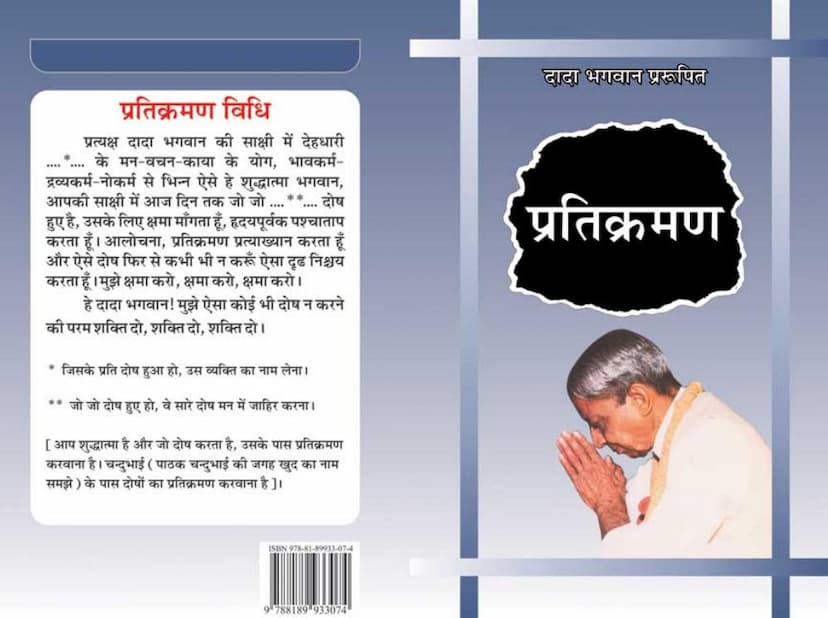Pratikraman
Added to library: September 2, 2025

Summary
Here's a comprehensive summary of the Jain text "Pratikraman" by Dada Bhagwan, based on the provided content:
Book Title: Pratikraman Author: Dada Bhagwan (Shri Ambalal Muljibhai Patel) Publisher: Mahavideh Foundation
Overall Purpose: The book "Pratikraman" by Dada Bhagwan is a guide to the Jain practice of Pratikraman, which translates to repentance, confession, and renunciation of past mistakes. It is presented as a profound spiritual science for achieving liberation (moksha) from the cycle of birth and death. Dada Bhagwan, a self-realized spiritual master, imparts this knowledge as an "uninterrupted path" (Akram Marg) to self-realization and freedom from karma.
Core Concepts and Practices Explained:
- Pratikraman as a "Weapon": Dada Bhagwan emphasizes that Pratikraman is an essential "weapon" gifted by the enlightened ones (like the Tirthankaras) to overcome the cycle of karma and achieve spiritual progress. It's presented as a direct solution to the complexities of life and spiritual striving.
- The "Akram Marg" (Uninterrupted Path): The book is rooted in Dada Bhagwan's unique spiritual teaching known as the Akram Marg. This path is described as a shortcut or a direct, non-sequential way to self-realization, contrasting with traditional gradual paths.
- The Nature of "Atikraman" (Transgression): Atikraman is defined as any action, speech, or thought that causes harm or a negative impact on another living being, leading to the binding of karma. This includes anger, pride, deceit, greed, and any action contrary to the five vows of Jainism.
- The Three Pillars of Pratikraman:
- Alochana (Confession): Openly acknowledging one's mistakes and wrongdoings. This involves confessing the nature of the transgression to a higher power or spiritual guide.
- Pratikraman (Repentance): Feeling sincere remorse and regret for the transgressions committed. This is a heartfelt acknowledgment of the wrong and a desire for purification.
- Pratyakhyan (Renunciation/Vow): Making a firm resolve never to repeat the mistake again. This is a commitment to change and avoid future transgressions.
- The Role of "Dada Bhagwan": The practice of Pratikraman is performed in the presence and witness of "Dada Bhagwan," who is described as the "Pure Soul" within, the Lord of the fourteen realms, and the Inner Self. This is not the physical body of A.M. Patel, but the divine presence within all beings, fully manifest in Dada Bhagwan.
- "Shoot on Sight" Principle: The ideal practice of Pratikraman is to perform it immediately after a transgression is committed, rather than delaying it. This "shoot on sight" approach is crucial for immediate purification and preventing further karmic entanglement.
- Distinction between "Atikraman" and "Kraman" (Innocent Action): Not all actions are considered transgressions. Innocent actions, or those that are natural and do not cause harm, are called kraman. Atikraman is specifically about actions that transgress moral or spiritual principles and cause suffering to others.
- Karma and its Resolution: The book explains that good deeds create credit and bad deeds create debit in one's karmic account. Pratikraman, by purifying the intentions and resolving to change, helps to "wash away" these karmic debts, preventing them from binding the soul further.
- Importance of Sincerity: The effectiveness of Pratikraman hinges on genuine remorse and a sincere resolve to change. Such repentance, performed with true heart and sincerity, is said to purify the soul.
- Pratikraman in Different States: Pratikraman can be performed with external actions or internally through thought and remembrance. Even when one is unaware or makes a mistake inadvertently, repentance is still necessary.
- Overcoming Negative Qualities: The book details how Pratikraman is essential for overcoming anger, pride, deceit, greed (kashays), and other negative tendencies that bind the soul.
- The Science of Pratikraman: Dada Bhagwan presents Pratikraman as a scientific process of purification. He explains the subtle workings of karma and how Pratikraman effectively counters it, leading to spiritual progress.
- The Role of the "Gnani Purush" (Self-Realized Soul): While the essence of Pratikraman can be understood and practiced, true and deep purification is best achieved through the guidance of a Gnani Purush, who can facilitate the process of self-realization. The book encourages seeking such guidance.
- The Impact of Intention (Abhipray): The book stresses that the underlying intention behind an action is crucial. Even if a mistake is made, if the intention is pure, and repentance is sincere, it mitigates the karmic consequence.
- The Practice of Asking for Strength: Along with repentance, it is advised to ask "Dada Bhagwan" for the strength to avoid future mistakes. This is seen as essential for true change.
- Pratikraman for Different Life Situations: The book provides examples of how to apply Pratikraman in various scenarios, such as conflicts in business, family disputes, personal habits, and even unintentional harm to living beings.
- The "Nine Lines" (Nau Kalmo): Mentioned towards the end, these are considered a core teaching of Dada Bhagwan, encapsulating essential principles and requests for spiritual strength and progress.
Key Takeaways:
- Responsibility for Actions: The book emphasizes that individuals are responsible for their actions, thoughts, and words.
- Continuous Spiritual Practice: Pratikraman is not a one-time event but a continuous practice for spiritual growth and purification.
- Self-Reliance in Purification: While external guidance is valuable, the power of sincere repentance and a firm resolve lies within the individual.
- The Goal of Liberation: The ultimate aim of practicing Pratikraman, as taught by Dada Bhagwan, is to break free from the cycle of karma and attain moksha.
In essence, "Pratikraman" by Dada Bhagwan serves as a practical and profound guide for individuals seeking spiritual purification and liberation. It demystifies the process of dealing with past mistakes and offers a direct, scientific method to cleanse the soul and progress on the path to self-realization.